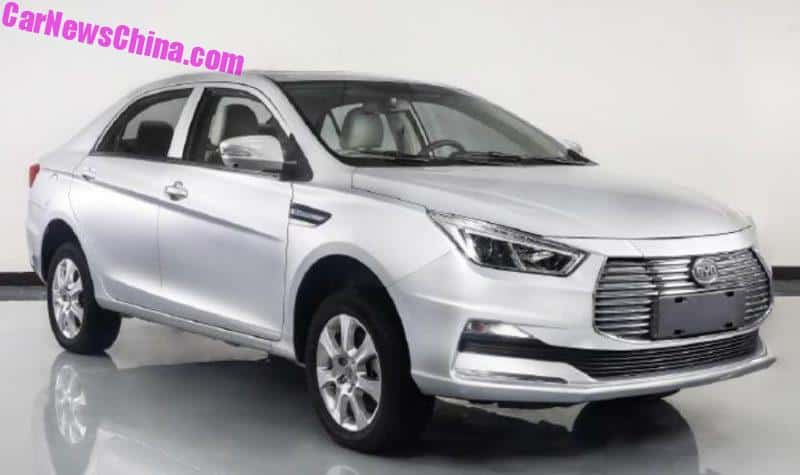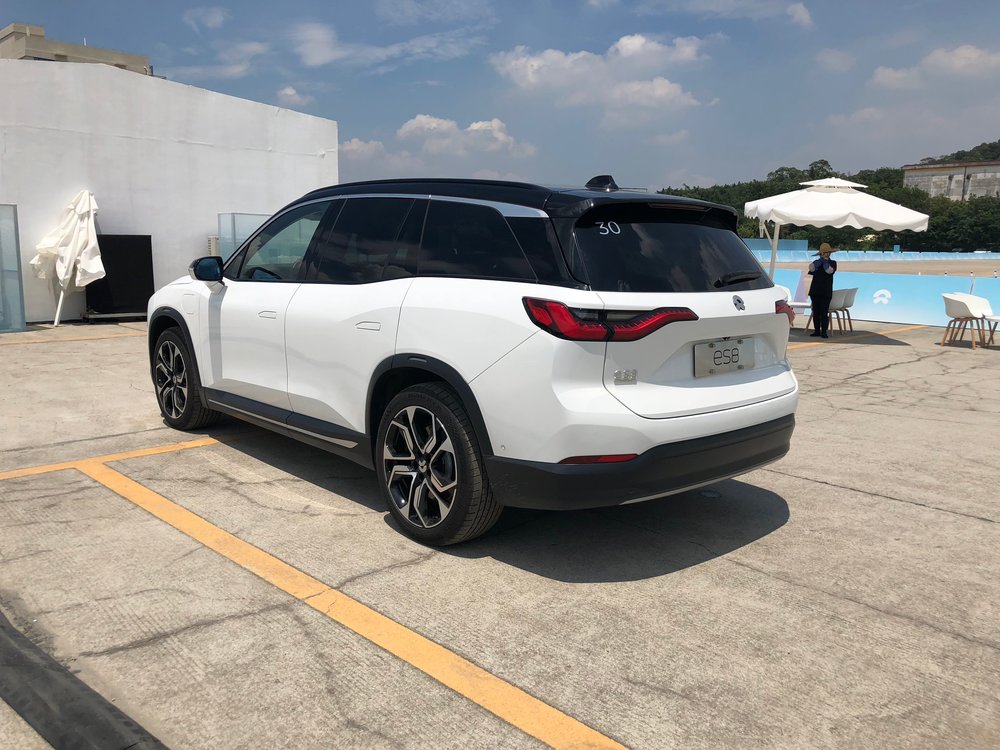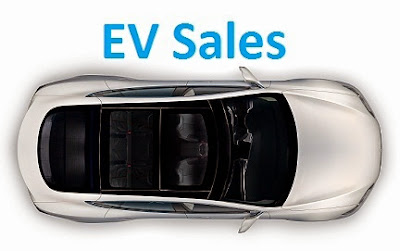
Yuan EV
reaches 10,000 units in BYD fest
Traditionally, January, along with February, are the
two slowest months in the Chinese plugin market, but tradition is not what it
used to be, and with disruption hitting the Chinese automotive market (the
mainstream market was down 18% last month), PEV sales were up an amazing 175%(!)
YoY, to some 96,000 units, pulling the PEV market share to 4.8%, already above
the 2018 result (4.2%), and all of the sudden, my previous forecast for the
final 2019 share (8%) seems conservative. Will we see it go North of 10% by the
end of December?
With all this continued growth, we should see sales double
this year, surpassing the 2 million mark, making some 60% of all global PEV sales
in 2019.
This ranking
still has some numbers missing, namely imports, but considering we have already
over 90% of this month sales tracked, and the exciting results that have been
made, we decided to publish right now what we have and update the final numbers
later.
With symbolic export numbers, the domestic market is
more than enough to absorb the current Chinese production, and most foreign
OEMs only now are starting to tackle the current seismic changes, dragged into
electrification by the new PEV quotas, resulting in the foreign brands total share
still being stuck at 5% (imports are
still missing, so this number should grow a little, to some 8%).
Of this (small) cake, 2% belong to Volkswagen, by far the
Best-Selling foreign brand, with the remaining manufacturers sharing the remaining
3% (Tesla should have some 2%, once the
final numbers are in).
In January, the headlining news were the BYD Dynamic Duo (Yuan and Tang) continued Rise and Rise, with the first surpassing
for the first time the 10,000 units in one month.
Here’s January
Top 5 Best Selling models individual performance:
#1 – BYD Yuan EV: We all knew that BYD’s new Baby Crossover was destined for success,
and with yet another record of 10,093
deliveries in January, the first time a BYD hits five digits in one month, the
brand Star Player is living up to
expectations, eating everybody’s
lunch, on the way. With a 40,000-long waiting list, demand is no problem,
depending more on BYD’s ability/willingness to make them in large volumes (The
Tang is more profitable…), than anything else. With unrivalled specs (42 kWh
battery, 305 kms/190 mi NEDC range, 174 hp motor), and price (25,000 USD), success
is guaranteed, but for some reason BYD still thinks it’s not good enough, so
they are going to upgrade the battery to some 58kWh this year…If they have a
long waiting list now, imagine then!

#2 – SAIC Baojun
E100: Shanghai
Auto and General Motors had high hopes for their tiny two-seater, and despite
an irregular career, the tiny two-seater is finally making an impact on the
Chinese plug-in market, having registered a record 8,312 units last month. With an updated range in 2018 (250 kms
NEDC), thanks to a new 24 kWh battery, its price (CNY 93,900 / USD 14,700)
before subsidies, is quite alluring, especially considering its modern design
and features. Maybe GM should consider exporting it? I mean, it’s not like they
have a strong EV lineup…

#3 – BYD Tang PHEV: After 9 months on the market, the
second-generation Tang continues to expand sales, registering a record 6,908 registrations. Sales should continue
strong for BYD’s successful flagship, and new record sales could still be
achieved in the future, although the upcoming (and much anticipated) Tang BEV
could steal sales from it. As for the current Tang PHEV specs, BYD’s Midsize SUV saw the battery grow to 24
kWh, originating an increased 100 kms range / 62 mi NEDC (around 70 kms / 44 mi
real world), while on the power department, things have stayed the same, but with
500 hp and 0-100 kms/h in less than 5 secs, one can’t really say it was
underpowered.... All for CNY 279,800 / $40,816.

#4 – BYD e5: BYD’s bread and butter electric sedan, a favorite among
taxi-drivers, registered 3,968 units
in January, and yet, this performance was overshadowed by their team stars Tang
and Yuan. This Andre Iguodala (Who?)
of the BYD lineup, has great specs (61 kWh, 405 kms / 253 mi range NEDC, 218
hp), considering the price (CNY 220,650 / USD 34,600). With a new, attractive
design (finally!), the nameplate is set to continue its brilliant work as the
lesser known team member of an All-Stars-rich Shenzhen Warriors Team...

#5 – BAIC EU-Series: After the record 12,561 units
of December, allowing it to be that month Best Seller, BAIC’s electric sedan returned
to more normal performances, with 3,895 units being delivered last month,
narrowly losing out to its BYD e5 nemesis.
The revised design and improved specs (215 hp, 416 kms / 260 mi NEDC, $32,500)
allows it to remain a popular choice and resist the BYD Blitzkrieg (the EC-Series can’t say the same…), so it seems the
sedan is going to be Beijing Auto’s main bet for 2019.
 |
| NIO ES8 |
2019 ranking
In such an
amazing month, there were plenty of models shining, besides the aforementioned
records mentioned in the Top 5 Sellers, there were fresh faces scoring record
results, like the #9 Geely Emgrand GSE EV compact SUV registering a record 2,808
units, the singular #14 Great Wall
Ora iQ5 EV crossover scoring 2,036 units, a new personal best for the Great
Wall nameplate, and finally the #18 Lifan 820 EV midsize sedan delivering a
record 1,682 units.
Another
interesting feature in the big reshuffle of the January ranking, is that in the
middle of the large number of new faces on the Top 20, we have a couple of export-minded
models that are finally surfacing in the Top 20, like the full-size SUV Nio ES8,
in #16, with 1,803 deliveries, being January’s Best Selling Luxury model, while
the #17 GAC Trumpchi GE3 compact crossover registered 1,683 units.
Looking at
the manufacturers ranking, BYD (22%) is a comfortable leader, thanks to the
success of the Yuan and Tang (and the #4 e5, and the #7 Qin, and the #15 Song…it’s
a true BYD fest), while below it, there are significant shifts, with SAIC (14%)
in the 2nd Spot, ahead of Geely (7%), while BAIC (5%) had a terrible
entry in 2019, dropping to 4th, tied with Chery.
A special
word for BYD’s never ending expansion plans, besides the current lineup, that
can already be considered quite complete, with a subcompact crossover, compact
sedans and SUVs, and a flagship midsize SUV, not forgetting the complete range
of commercial vehicles, the brand will join new segments this year, with the e1
trying to get a piece of the large City EV
market, while the Song MAX, both in PHEV and BEV formats, will join the
7-seater MPV/Minivan category, with even more models coming in 2020, including
a mysterious Han sports car, said to have Tesla-like acceleration specs and
over 700 kms range…
One wonders
where they will get enough batteries for all that, but then again, they are
their own supplier, so just like Tesla, BYD is not dependent from third party
supply issues and contracts, which really separates both EV makers from the
rest of the competition into a league of their own, allowing them also to
upgrade their batteries more frequently, thus winning a critical advantage over
their competitors.


I did expect the Nissan Sylphy ZE in this months list.
ReplyDeleteAnd I did have the impression that NEVS did start production for those crazy (perhaps not real) orders from China.
Or are these among the missing numbers?
The Sylphy had a week month, some 200 units. As for NEVS, i still haven't had news of registrations, but then again, it might still be among the missing 5-10% units.
DeleteJose,
ReplyDeleteIt's nice to see new names of EV models in the top 20 list. And that was to be expected anyway.
What I wouldn't have expected is that the BAIC EC-Series wouldn't be in the top 20 at all.
What happened?
There must be an explanation for that.
Have so many potential buyers of the BAIC EC-Series suddenly changed their minds and massively decided to buy some other EV models?
Or is there some other explanation for this?
Cheers
I have been thinking on that too, maybe orders have been shrinking, and they decided to give priority to the EU-Series.
DeleteNevertheless, that doesn't explain the big drop in the makers ranking, from #2 to #4.
BAIC BJEV only produced 142 cars in January, production has been largely shutdown. There are some reports this was due to battery supply issues, and also due to retooling production for EX3 and EC5.
DeleteBloomberg NEF has predicted that the growth rate in the Chinese EV market will slow down this year. So far this prediction does not seem to be correct.
ReplyDeleteYep, predictions are too optimistic. Incentives will start to phase out this year. Too soon unfortunately
ReplyDeleteJose,
ReplyDeletePerhaps the Nissan Sylphy ZE is probably just outside the top 20 in China.
How many of them were sold in China in January 2019?
Perhaps it will enter the top 20 in the coming months?
Cheers
The 200 Sylphy units are a disappointment, let's see how the next months go, but it seems there were some makers antecipating the current disruption, which allowed them to continue producing in high numbers, while others expected the market would go down, like in previous years, programming a production slowndown in the first two months of the year.
DeleteIt this is the case, then March will be a record-breaking month.
What happened to EC-Series?
ReplyDeleteAs far as I know, they stopped production in December for some reason
DeleteYes, something strange happened in BAIC's plant(s).
DeleteWhere is Tesla in China? Did it disappear at all?
ReplyDeleteWe still do not have imports data.
DeleteIn January 2018, Tesla only delivered 500 Model X and fewer than 360 Model S in China. They'd have to nearly triple the Model X's sales performance to have it make the top 20 list in January 2019.
DeleteMy understanding is that the first Model 3 deliveries to Customers in China only occurred on February 22nd. This first batch only had ~1600 Model 3 in it and ~200 Model S and X on it, and another boat isn't expected to arrive until March, so I think it's quite possible that Tesla won't make the top 20 in China in February, either.
I expect several shipments of thousands of Model 3 will arrive in China in March, though, and that should push the Model 3 into the top 5 in China for March.
There is people "spying" every car carrier with Tesla cars. :)
DeleteUntil last Friday, only "Glovis Symphony" ship had arrived in China with the first 1600 Model 3.
Since then, "Morning Cindy" ship has arrived in Shanghai.
Then, "Emerald Ace" ship will arrived in Tianjin tomorrow.
"Golden Ray" ship is due to arrive in Shanghai in 01/03.
4.8% in January? I read several times that China has imposed a quota of 10% EV's from 2019 on. Am I mistaken?
ReplyDeleteThat 10% is cradits not actuall market share
DeleteIn reality, the quota on each brand depends, because the number can be much lower (3-4%) if the brand takes the credit system to full advantage (eg long range BEVs), but if a given brand only has PHEVs, then it will have have to fulfill the whole 10%.
DeleteYou can get 2 credits for PHEVs so even with only PHEVs you could get as low as 5% of total sales.
DeleteLong range BEVs can earn up to 6 credits, so this would only be 1.7% share of NEVs required. The average credits per car in January was 3.93, so only 2.5% NEV market share will be required on average in 2019. Given NEV penetration is already 4-8%, I don't think the NEV credit scheme is enough to be a market driver unless China significantly increases the requirements.
DeleteThe 4% EV market share of 2018 was mostly local brands (above 90%). So while the new quotas will not put pressure on local car companies, it forces foreign ones, which represent like half of total car market, to step up the game significantly.
DeleteExacly.
DeleteI think so about BYD and wish they sell cars in Europe and USA.(I apprishiate your job, I never commented before but see your blog everyday. Do not stop making this. This is important for EV revolution (I think).)
ReplyDeleteThank you, it's always good to hear nice words!
DeleteJose,
ReplyDeletePresident Trump has delayed an increase in tariffs that were initially scheduled for March 1.
Cheers
Thank you for the input.
DeleteHere is a good talk to better understand the Chine market: https://about.bnef.com/summit/sanfrancisco/videos/?vid=316624242
ReplyDeleteHi Jose,
ReplyDeleteTwo BYD queries;
i) Where have you got data for the 40,000 preorders for the Yuan?
ii) What are the margins for the Yuan vs the Tang?
Such a wonderful blog, many thanks for maintaining it.
i) Chinese media (d1ev);
Deleteii) No idea, but i assume they have more margin on the larger and more expensive Tang.
Thanks! Do you have Canada numbers for December? (usually I can interpolate missing months, using the YTD sums, but that is not an option here)
ReplyDeleteplease send me na email (efeelblog@gmail.com)
Delete